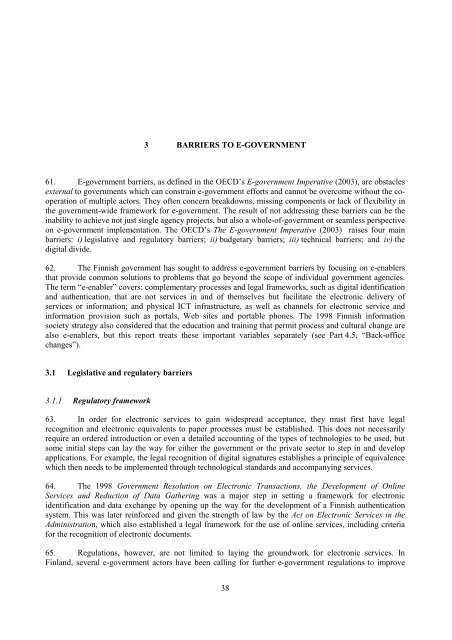e-GOVERNMENT IN FINLAND - ePractice.eu
e-GOVERNMENT IN FINLAND - ePractice.eu
e-GOVERNMENT IN FINLAND - ePractice.eu
You also want an ePaper? Increase the reach of your titles
YUMPU automatically turns print PDFs into web optimized ePapers that Google loves.
3 BARRIERS TO E-<strong>GOVERNMENT</strong><br />
61. E-government barriers, as defined in the OECD’s E-government Imperative (2003), are obstacles<br />
external to governments which can constrain e-government efforts and cannot be overcome without the cooperation<br />
of multiple actors. They often concern breakdowns, missing components or lack of flexibility in<br />
the government-wide framework for e-government. The result of not addressing these barriers can be the<br />
inability to achieve not just single agency projects, but also a whole-of-government or seamless perspective<br />
on e-government implementation. The OECD’s The E-government Imperative (2003) raises four main<br />
barriers: i) legislative and regulatory barriers; ii) budgetary barriers; iii) technical barriers; and iv) the<br />
digital divide.<br />
62. The Finnish government has sought to address e-government barriers by focusing on e-enablers<br />
that provide common solutions to problems that go beyond the scope of individual government agencies.<br />
The term “e-enabler” covers: complementary processes and legal frameworks, such as digital identification<br />
and authentication, that are not services in and of themselves but facilitate the electronic delivery of<br />
services or information; and physical ICT infrastructure, as well as channels for electronic service and<br />
information provision such as portals, Web sites and portable phones. The 1998 Finnish information<br />
society strategy also considered that the education and training that permit process and cultural change are<br />
also e-enablers, but this report treats these important variables separately (see Part 4.5, “Back-office<br />
changes”).<br />
3.1 Legislative and regulatory barriers<br />
3.1.1 Regulatory framework<br />
63. In order for electronic services to gain widespread acceptance, they must first have legal<br />
recognition and electronic equivalents to paper processes must be established. This does not necessarily<br />
require an ordered introduction or even a detailed accounting of the types of technologies to be used, but<br />
some initial steps can lay the way for either the government or the private sector to step in and develop<br />
applications. For example, the legal recognition of digital signatures establishes a principle of equivalence<br />
which then needs to be implemented through technological standards and accompanying services.<br />
64. The 1998 Government Resolution on Electronic Transactions, the Development of Online<br />
Services and Reduction of Data Gathering was a major step in setting a framework for electronic<br />
identification and data exchange by opening up the way for the development of a Finnish authentication<br />
system. This was later reinforced and given the strength of law by the Act on Electronic Services in the<br />
Administration, which also established a legal framework for the use of online services, including criteria<br />
for the recognition of electronic documents.<br />
65. Regulations, however, are not limited to laying the groundwork for electronic services. In<br />
Finland, several e-government actors have been calling for further e-government regulations to improve<br />
38
















